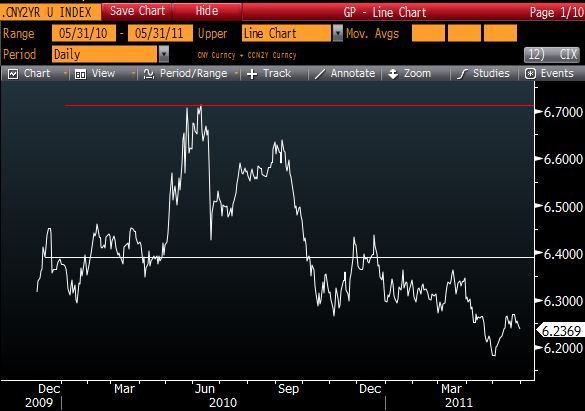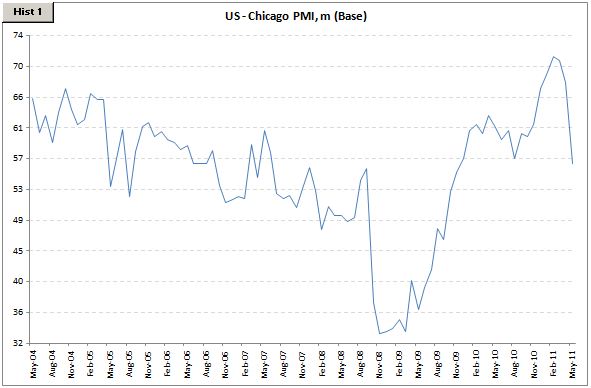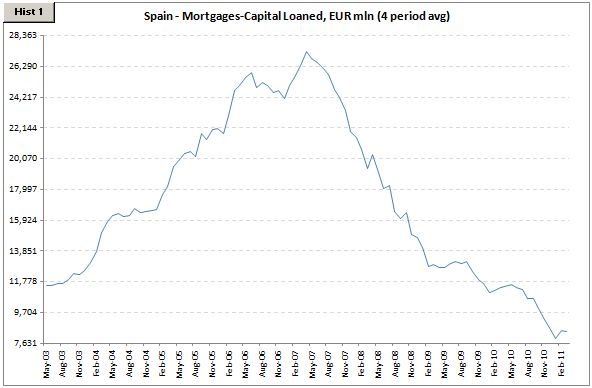So I have posted about this one trade in currencies:
The drivers are pretty straight-forward: I do not believe these countries will be able to get out of their current economic situation without printing their way out.
The Americans have a huge pile of sovereign and private debt. Policy makers won't be able to either raise interest rates or cut fiscal stimulus. Stimulus means printing. Raising rates means risky-markets should collapse bring economic activity with it. That means more all-kinds-of stimulus.
Repeat for the EUR block.
Repeat for the UK.
These 3 guys are now into the deleveraging process, coupled high unemployment, high fiscal deficits and retiree-wannabe-but-can't-cuz-I-got-no-savings baby boomers. Not to mention they have spent their small savings on an iPad 2 and a bunch of apps.
On the long side of the equation we have countries where demographics in most cases should remain reasonably good, where balance sheets are much, much better on aggregate, where real interest rates look better, where domestic demand is also reasonably robust and their exposure to commodities and global growth is alright.
What do they lack? They sort-of-lack capital. And that's the main risk to the trade.
Stress in the global financial markets means invested capital (hot money flows and FDI) fleeing these countries would happen, as history has taught us.
In this case we have added the CHF as the safe-heaven currency. And also we could get some JPY there even though I am NOT a fan of Japan. But these guys have massive savings in external assets and a (currently) positive current account. Capital flies to japanese-quality heaven when things go sour. This means in stress, as history has also shown us too, the JPY could also reduce the volatility of this trade, improving its risk-reward profile.
NOW.... I am siding with Mark Hart (Corriente Advisors) and Jim Chanos (Kynikos) on a bet against China.
First: because in case China goes bust or slows downs considerably these commodity-linked Currencies will take a beating. A hard one. Like they did in 2008. The Commodities market went bust before the Armageddon hit global equities. So currencies took a beating then too. That was China and its Housing Starts numbers going south in late 2007-early 2008.
Second: fundamentals.
Credit expansion (what a boost they had in early 2009, throughout today!) has been huge.
This credit fueled an impressive streak of fixed asset investments, but with overcapacity now lingering in some sectors and the domestic demand unable to pick-up as fast consuming these investments (be it through usage of roads or the purchase of 1st homes, etc) it seems to me some of this returns are bad and the credit is heading towards default.
Inflation is picking up, with food inflation being the worst (some say 10%), ghost towns are being formed (lots of videos on this out on the web, Frontline, Bloomberg, etc).
Third: Asymmetry
The market is packed on the long-CNY trade. That means lots of people selling volatility, perhaps to fund the short USDCNY trade through NDFs. Even though nominal rates in China are higher than those in the US the NDF curve is inverted (contrary to the curves in Brazil, Chile, Australia, etc, etc, etc). Investors are piling onto this trade and the NDF curve 3 years out has an implied 5.2% appreciation (1.70% year) even though rates differentials point to an 8% depreciation. That is a 13.2% gap. OK, I won't argue that market prices are market prices. But I'd like to accept this distortion which I find favorable.
With the CNY spot being controlled by the Chinese the market has priced in very, very low implied volatility for options on it.
And that means opportunity. Skew.
So what is the call here?
Buy 3y USDCNY Calls with a Strike of 6.80 (put CNY / call USD)
OTM from Spot: -4.7%
OTM from 3y fwd: -9.4%
Volatility was offered at 7.2% and the premium at 1.63%.
In 2010, when the European Debt Issues started roiling markets the 2y NDF (so consider this trade one year from now...) went from around 6.40 to 6.70, that is a 4.70% move. And historical volatility went from the bottom of 4.5% to around 10.60%. And implied volatility trades above historical volatility.
So with a decent stress I see this trade paying at least 3/5 to 1, so 5%-8% return. If the stress is actually bad enough (EUR taking a beating?) I see this multiplied by 2 or 3.
So...
The currency basket is a high yielding play with lower volatility due to its construction. It should perform well with low yields in the US/UK/Europe, with modest-to-low growth in these countries and the on-going growth in EM (read China). Basically status-quo.
And the HEDGE (CNY put / USD call), to me, is considered another new trade, but it actually adds to the portfolio nicely as I believe it serves a great hedge in case the world goes buh-bye again.
Opinions?
Questions?
"You are wrong!"?
LONG combination of these:commodities + strong domestic demand + good demographics and room for productivity gains + balance sheets + high yields > BRL, CLP, CAD, NOK, CHF (30% / 15% / 20% / 20% / 15%)
versus
SHORT Printing Presses: USD, EUR, GBP (33% each), perhaps short 3-5% AUD.
The drivers are pretty straight-forward: I do not believe these countries will be able to get out of their current economic situation without printing their way out.
The Americans have a huge pile of sovereign and private debt. Policy makers won't be able to either raise interest rates or cut fiscal stimulus. Stimulus means printing. Raising rates means risky-markets should collapse bring economic activity with it. That means more all-kinds-of stimulus.
Repeat for the EUR block.
Repeat for the UK.
These 3 guys are now into the deleveraging process, coupled high unemployment, high fiscal deficits and retiree-wannabe-but-can't-cuz-I-got-no-savings baby boomers. Not to mention they have spent their small savings on an iPad 2 and a bunch of apps.
On the long side of the equation we have countries where demographics in most cases should remain reasonably good, where balance sheets are much, much better on aggregate, where real interest rates look better, where domestic demand is also reasonably robust and their exposure to commodities and global growth is alright.
What do they lack? They sort-of-lack capital. And that's the main risk to the trade.
Stress in the global financial markets means invested capital (hot money flows and FDI) fleeing these countries would happen, as history has taught us.
In this case we have added the CHF as the safe-heaven currency. And also we could get some JPY there even though I am NOT a fan of Japan. But these guys have massive savings in external assets and a (currently) positive current account. Capital flies to japanese-quality heaven when things go sour. This means in stress, as history has also shown us too, the JPY could also reduce the volatility of this trade, improving its risk-reward profile.
NOW.... I am siding with Mark Hart (Corriente Advisors) and Jim Chanos (Kynikos) on a bet against China.
First: because in case China goes bust or slows downs considerably these commodity-linked Currencies will take a beating. A hard one. Like they did in 2008. The Commodities market went bust before the Armageddon hit global equities. So currencies took a beating then too. That was China and its Housing Starts numbers going south in late 2007-early 2008.
Second: fundamentals.
Credit expansion (what a boost they had in early 2009, throughout today!) has been huge.
This credit fueled an impressive streak of fixed asset investments, but with overcapacity now lingering in some sectors and the domestic demand unable to pick-up as fast consuming these investments (be it through usage of roads or the purchase of 1st homes, etc) it seems to me some of this returns are bad and the credit is heading towards default.
Inflation is picking up, with food inflation being the worst (some say 10%), ghost towns are being formed (lots of videos on this out on the web, Frontline, Bloomberg, etc).
Third: Asymmetry
The market is packed on the long-CNY trade. That means lots of people selling volatility, perhaps to fund the short USDCNY trade through NDFs. Even though nominal rates in China are higher than those in the US the NDF curve is inverted (contrary to the curves in Brazil, Chile, Australia, etc, etc, etc). Investors are piling onto this trade and the NDF curve 3 years out has an implied 5.2% appreciation (1.70% year) even though rates differentials point to an 8% depreciation. That is a 13.2% gap. OK, I won't argue that market prices are market prices. But I'd like to accept this distortion which I find favorable.
With the CNY spot being controlled by the Chinese the market has priced in very, very low implied volatility for options on it.
And that means opportunity. Skew.
So what is the call here?
Buy 3y USDCNY Calls with a Strike of 6.80 (put CNY / call USD)
OTM from Spot: -4.7%
OTM from 3y fwd: -9.4%
Volatility was offered at 7.2% and the premium at 1.63%.
In 2010, when the European Debt Issues started roiling markets the 2y NDF (so consider this trade one year from now...) went from around 6.40 to 6.70, that is a 4.70% move. And historical volatility went from the bottom of 4.5% to around 10.60%. And implied volatility trades above historical volatility.
So with a decent stress I see this trade paying at least 3/5 to 1, so 5%-8% return. If the stress is actually bad enough (EUR taking a beating?) I see this multiplied by 2 or 3.
So...
The currency basket is a high yielding play with lower volatility due to its construction. It should perform well with low yields in the US/UK/Europe, with modest-to-low growth in these countries and the on-going growth in EM (read China). Basically status-quo.
And the HEDGE (CNY put / USD call), to me, is considered another new trade, but it actually adds to the portfolio nicely as I believe it serves a great hedge in case the world goes buh-bye again.
Opinions?
Questions?
"You are wrong!"?
*Disclaimer: charts and data are presented as I receive/see them. Sources are usually not checked for validation and my own calculations are of 'back of the envelope'-type. I am aware that some math that I do myself might be wrong and/or misleading to some extent. In financial markets the rate of change of economic data is often more important than the actual level and the perception of 'what is priced in' is more important than 'what is actually going to happen'. This is actually the way people pick entry and exit points. So... yes, sometimes you might say 'This guy is an idiot, this is way wrong!' with a high conviction, being right. Not to worry. Markets are made of expectations and the clash of conviction between its participants. Portfolio managers know that being an idiot is sometimes profitable and being smart is often a bad choice. It is all reality, sometimes good, sometimes bad. By the way: corrections to my analysis and intelligent debate is welcome. theintriguedtrader AT gmail do com






![[image]](https://mm.jpmorgan.com/stp/t/c.do?imgName%3D1155374654.jpg%26docId%3DGPS-603119-0)











































